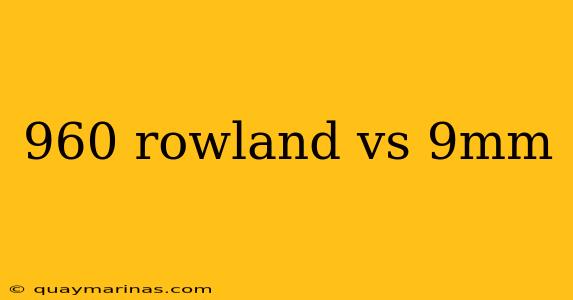Choosing the right cartridge for your handgun is a crucial decision, impacting everything from accuracy and stopping power to recoil management and cost. This in-depth comparison of the .960 Rowland and 9mm Parabellum will help you understand the key differences and decide which cartridge best suits your needs.
Understanding the Contenders: .960 Rowland and 9mm
The 9mm Parabellum (also known as 9x19mm) is a ubiquitous cartridge, renowned for its balance of power, accuracy, and manageable recoil. Its widespread availability and affordability make it a popular choice for both law enforcement and civilian shooters.
The .960 Rowland, on the other hand, is a relatively new, high-pressure cartridge developed by Rowland Custom Works. It's designed to deliver significantly more power than the 9mm, while still being compatible with many standard 9mm handguns – often with minor modifications like a stronger recoil spring. This makes it a compelling option for those seeking increased stopping power within the familiar 9mm platform.
Key Differences: Power and Performance
The most significant difference between these two cartridges lies in their ballistic performance. The .960 Rowland delivers substantially more energy and muzzle velocity than the 9mm. This translates to a flatter trajectory, increased range, and, arguably, superior stopping power.
| Feature | 9mm Parabellum | .960 Rowland |
|---|---|---|
| Muzzle Velocity | ~1100-1250 fps | ~1400-1550 fps |
| Muzzle Energy | ~350-400 ft-lbs | ~600-700 ft-lbs |
| Recoil | Moderate | Significantly Higher |
| Cartridge Length | Shorter | Longer |
| Availability | Extremely Wide | More Limited |
| Cost | Relatively Low | Relatively High |
Stopping Power: A Critical Consideration
While muzzle energy is a good indicator, stopping power is a complex issue influenced by factors beyond just energy. Bullet construction (jacketed hollow point, full metal jacket, etc.), shot placement, and the target's physiology all play a significant role. The increased energy of the .960 Rowland suggests improved stopping power, but definitive conclusions require rigorous testing and analysis, and are subject to debate among experts.
Practical Considerations: Gun Modifications and Availability
One critical aspect to consider is the compatibility with your handgun. While many 9mm pistols can be converted to fire the .960 Rowland (often requiring only a stronger recoil spring and barrel change), not all are suitable. Improper modifications can lead to dangerous malfunctions. Consult with a qualified gunsmith to determine if your firearm is compatible.
The availability of ammunition is another factor. 9mm ammunition is readily available almost everywhere. Finding .960 Rowland ammunition might require more effort and may be significantly more expensive.
Cost Analysis: Ammunition and Conversions
The cost of .960 Rowland ammunition generally exceeds that of 9mm significantly. Add to this the potential cost of converting your handgun, and the overall expenditure could be substantial. This is a crucial factor to weigh against the performance benefits.
Conclusion: Choosing the Right Cartridge
The choice between the 9mm and .960 Rowland depends heavily on your individual priorities and intended use. The 9mm offers a practical balance of power, accuracy, affordability, and readily available ammunition. The .960 Rowland, while providing significantly more power, demands careful consideration of cost, availability, and potential modifications to your firearm. If you require maximum stopping power and are willing to accept higher recoil and increased costs, the .960 Rowland may be worth exploring. However, for most users, the 9mm remains a reliable and versatile choice. Always prioritize safety and consult with experienced firearm professionals before making any modifications or choosing a cartridge for your handgun.
